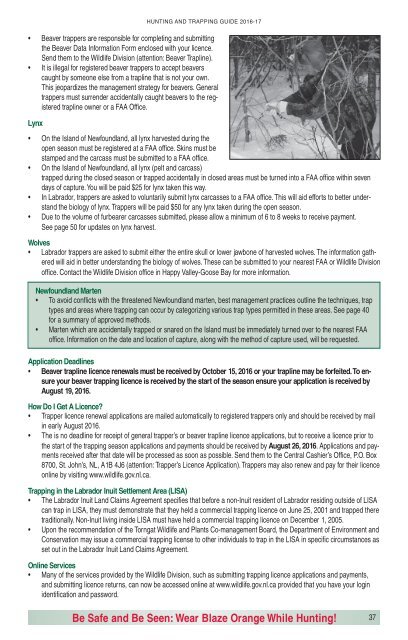Hunting & Trapping
2cjuBGz
2cjuBGz
Create successful ePaper yourself
Turn your PDF publications into a flip-book with our unique Google optimized e-Paper software.
HUNTING AND TRAPPING GUIDE 2016-17<br />
• Beaver trappers are responsible for completing and submitting<br />
the Beaver Data Information Form enclosed with your licence.<br />
Send them to the Wildlife Division (attention: Beaver Trapline).<br />
• It is illegal for registered beaver trappers to accept beavers<br />
caught by someone else from a trapline that is not your own.<br />
This jeopardizes the management strategy for beavers. General<br />
trappers must surrender accidentally caught beavers to the registered<br />
trapline owner or a FAA Office.<br />
Lynx<br />
• On the Island of Newfoundland, all lynx harvested during the<br />
open season must be registered at a FAA office. Skins must be<br />
stamped and the carcass must be submitted to a FAA office.<br />
• On the Island of Newfoundland, all lynx (pelt and carcass)<br />
trapped during the closed season or trapped accidentally in closed areas must be turned into a FAA office within seven<br />
days of capture. You will be paid $25 for lynx taken this way.<br />
• In Labrador, trappers are asked to voluntarily submit lynx carcasses to a FAA office. This will aid efforts to better understand<br />
the biology of lynx. Trappers will be paid $50 for any lynx taken during the open season.<br />
• Due to the volume of furbearer carcasses submitted, please allow a minimum of 6 to 8 weeks to receive payment.<br />
See page 50 for updates on lynx harvest.<br />
Wolves<br />
• Labrador trappers are asked to submit either the entire skull or lower jawbone of harvested wolves. The information gathered<br />
will aid in better understanding the biology of wolves. These can be submitted to your nearest FAA or Wildlife Division<br />
office. Contact the Wildlife Division office in Happy Valley-Goose Bay for more information.<br />
Newfoundland Marten<br />
• To avoid conflicts with the threatened Newfoundland marten, best management practices outline the techniques, trap<br />
types and areas where trapping can occur by categorizing various trap types permitted in these areas. See page 40<br />
for a summary of approved methods.<br />
• Marten which are accidentally trapped or snared on the Island must be immediately turned over to the nearest FAA<br />
office. Information on the date and location of capture, along with the method of capture used, will be requested.<br />
Application Deadlines<br />
• Beaver trapline licence renewals must be received by October 15, 2016 or your trapline may be forfeited. To ensure<br />
your beaver trapping licence is received by the start of the season ensure your application is received by<br />
August 19, 2016.<br />
How Do I Get A Licence?<br />
• Trapper licence renewal applications are mailed automatically to registered trappers only and should be received by mail<br />
in early August 2016.<br />
• The is no deadline for receipt of general trapper’s or beaver trapline licence applications, but to receive a licence prior to<br />
the start of the trapping season applications and payments should be received by August 26, 2016. Applications and payments<br />
received after that date will be processed as soon as possible. Send them to the Central Cashier’s Office, P.O. Box<br />
8700, St. John’s, NL, A1B 4J6 (attention: Trapper’s Licence Application). Trappers may also renew and pay for their licence<br />
online by visiting www.wildlife.gov.nl.ca.<br />
<strong>Trapping</strong> in the Labrador Inuit Settlement Area (LISA)<br />
• The Labrador Inuit Land Claims Agreement specifies that before a non-Inuit resident of Labrador residing outside of LISA<br />
can trap in LISA, they must demonstrate that they held a commercial trapping licence on June 25, 2001 and trapped there<br />
traditionally. Non-Inuit living inside LISA must have held a commercial trapping licence on December 1, 2005.<br />
• Upon the recommendation of the Torngat Wildlife and Plants Co-management Board, the Department of Environment and<br />
Conservation may issue a commercial trapping license to other individuals to trap in the LISA in specific circumstances as<br />
set out in the Labrador Inuit Land Claims Agreement.<br />
Online Services<br />
• Many of the services provided by the Wildlife Division, such as submitting trapping licence applications and payments,<br />
and submitting licence returns, can now be accessed online at www.wildlife.gov.nl.ca provided that you have your login<br />
identification and password.<br />
Be Safe and Be Seen: Wear Blaze Orange While <strong>Hunting</strong>! 37


